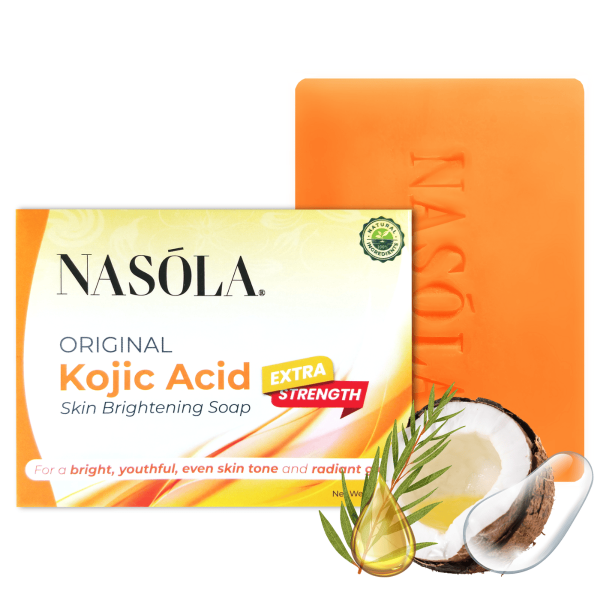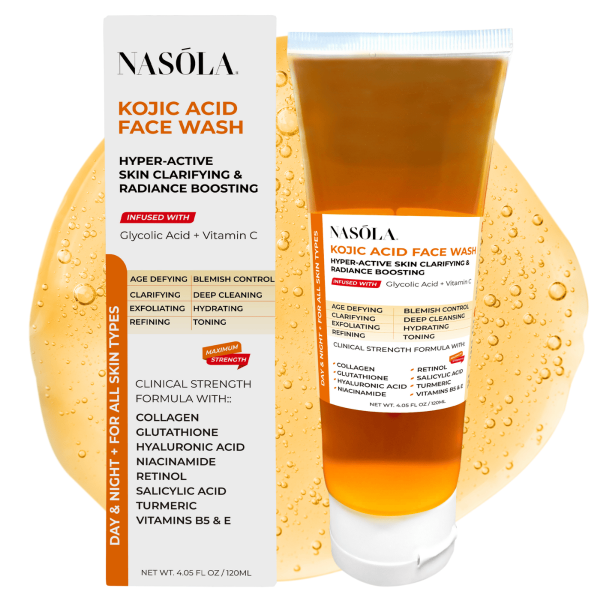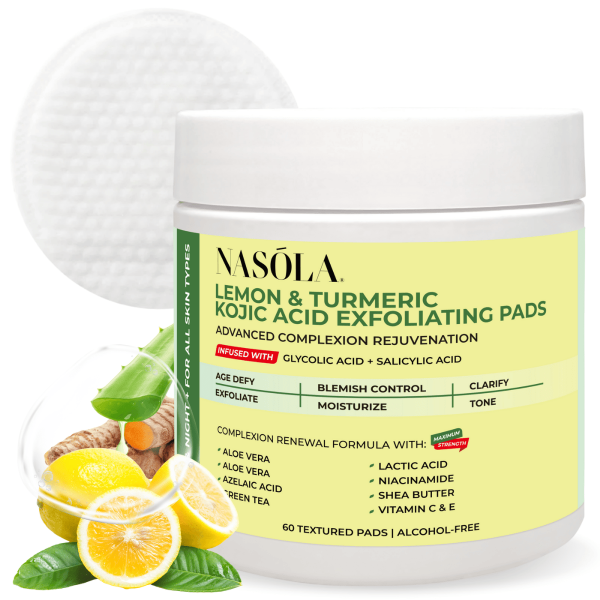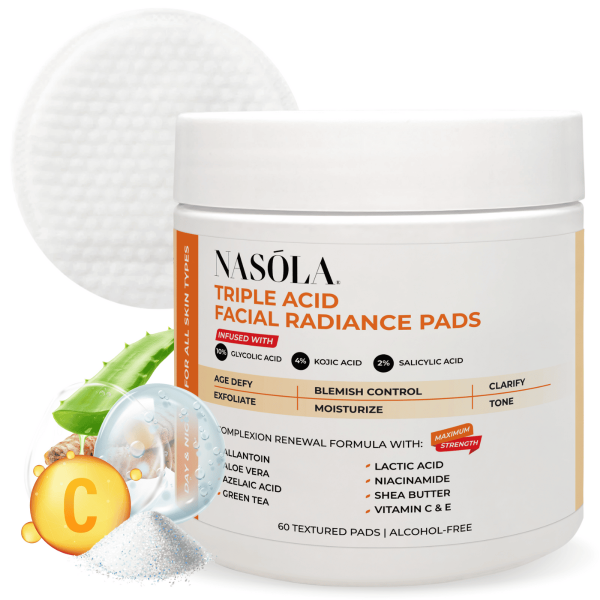If you’ve been staring into the mirror—nose nearly pressed to the glass—wondering why those tiny gray dots won’t budge no matter how hard you scrub… I hear you.
Most likely? Those stubborn specks aren’t blackheads at all. They’re sebaceous filaments. And surprise: they’re supposed to be there. But that doesn’t mean we can’t refine how they look with the right care.
That starts with the best oil cleanser for sebaceous filaments.
In this blog, we’ll look at what sebaceous filaments actually are (spoiler: not your enemy), how to calm their appearance, and the ingredients that matter most. I’ll break it all down—supporting your routine with solid product picks like the Nasola Triple Acid Facial Radiance Pads, Nasola Lemon Turmeric Kojic Acid Exfoliating Pads, Nasola Kojic Acid Face Wash, and Nasola Kojic Acid Soap.
Let’s clean house—pore by pore.
- Ingredient Spotlight: Why Oil-Based Cleansing Works with Sebaceous Filaments
- The Best Oil Cleanser for Sebaceous Filaments: What to Look For
- Exfoliation and ACIDS: Removing the Build-Up Gently
- Brightening the Skin While Clearing Sebaceous Filaments
- Maintaining Skin Barrier Health After Deep Cleansing
- Gentle Yet Powerful: Daily Use Products That Support Pore Cleanliness
- Consistency is Queen: Long-Term Habits with the Best Oil Cleanser for Sebaceous Filaments
- Conclusion
- Frequently Asked Questions
Ingredient Spotlight: Why Oil-Based Cleansing Works with Sebaceous Filaments
Sebaceous filaments thrive in oily zones—especially your T-zone—and oil cleansing can be your secret weapon to keeping them under control.
The best oil cleanser for sebaceous filaments doesn’t just “remove dirt.” It binds with your skin’s natural oils to melt away buildup, excess sebum, and the grungy bits clogging your pores.
This is skincare that respects your biology, not fights it. Think of oil cleansers like gentle negotiators convincing excess oil to leave. We’re not blasting your skin with harsh detergents here—we’re rebalancing it.
Let’s break it down:
Tackling Congestion With Nourishing Oils
When your pores are congested, your instinct might be to attack them with astringents or foaming face washes. Please don’t. Instead, look to jojoba, rosehip, and squalane oils—they’re chemically similar to the sebum your skin naturally produces.
Translation? They blend in like undercover agents and convince hardened oil plugs to dissolve and leave. Over time, this softens the appearance of sebaceous filaments and minimizes your tendency to overproduce oil.
Here’s what the right oil cleanser should offer:
- Jojoba oil: regulates oil without clogging pores.
- Squalane: deeply nourishing and mimics natural sebum.
- Sunflower oil: rich in linoleic acid to keep pores clear.
- Rosehip seed oil: gives extra glow and helps fade scars.
Use one daily in your evening routine—with patience, you’ll start seeing clarity without tightness.
Why Over-stripping Backfires
Let’s talk about the war many of us have been waging against our oil glands. Over-cleansing may give temporary satisfaction (you feel squeaky clean, yay), but it also tells your skin it’s in a desert…so it produces more oil.
And what happens?
A vicious cycle of buildup and congestion returns, more stubborn than before.
When you choose a balanced oil cleanser, you:
- Allow your skin’s microbiome to flourish.
- Reduce inflammation around your pores.
- Prevent compensatory oil production.
- Maintain hydration levels while purging deep grime.
That’s the kind of skincare alliance we’re after: calm, balanced, boss-level glow.
The Best Oil Cleanser for Sebaceous Filaments: What to Look For

So what exactly makes something the best oil cleanser for sebaceous filaments? Think: ingredients that mirror your skin…without inviting drama. It’s a tightrope act. The wrong oil can send your skin spiraling. The right one? Game-changer.
Look for oils that nourish but rinse off clean, and steer clear of ingredients that stick around (or clog up) longer than they should.
Look for Non-Comedogenic Oils
Not all oils are created equal when it comes to congestion-prone skin. If you’re going oil-first, you need options that won’t sit heavy inside your pores.
Enter non-comedogenic oils—hydrating enough to cleanse but light enough to wash away without residue.
The best options include:
- Grapeseed oil: lightweight, antioxidant-rich, and full of linoleic acid.
- Jojoba oil: a miracle worker that mimics your own skin’s oils.
- Safflower oil: absorbs quickly and cuts through greasy buildup.
- Hemp seed oil: balances without triggering more sebum.
We’re aiming for gentle emulsification, not greasy leftovers.
Ingredients to Avoid
This is equally important! Fast exit stage left to oils and additives that suffocate your pores and worsen texture.
Avoid:
- Mineral oil: hard to remove and can trap debris.
- Coconut oil: yes, it smells nice—but highly comedogenic.
- Artificial fragrances: potential irritants that trigger inflammation.
- Isopropyl myristate: makes skin feel silky but clogs pores like crazy.
After your oil cleanse, I recommend following up with Nasola Kojic Acid Face Wash. Formulated with kojic acid and turmeric extract, it helps clean what oil dissolves. Plus, it brightens gently over time—bonus!
Exfoliation and ACIDS: Removing the Build-Up Gently
An oil cleanser clears the upper surface of your pores. But what about that grime buried a little deeper? That’s where acids come in. Used right, they’re the cleanup crew, loosening up that clingy filth and prepping your skin for refinement.
Pairing the best oil cleanser for sebaceous filaments with exfoliating acids powers up your pore care.
Salicylic, Lactic & Glycolic Acid Synergy
You don’t need harsh peels or aggressive scrubs. Chemical exfoliants like glycolic acid, lactic acid, and salicylic acid work below the surface.
Here’s how they work together:
- Glycolic acid: exfoliates the outermost layer and shrinks the look of large pores.
- Lactic acid: hydrates while smoothing texture.
- Salicylic acid: penetrates oil and clears deep congestion inside the pore lining.
- AHAs and BHAs: together, they banish that stubborn buildup without angering your skin.
Use them 2–4x a week depending on your tolerance. Overdoing it = redness and sensitivity. And no one needs that.
To simplify it all? Grab the Nasola Triple Acid Facial Radiance Pads. They’re soaked with glycolic, lactic, and salicylic acids for targeted, balanced resurfacing. So quick, so effective.
Why Over-Exfoliation is Harmful
Too much of a good thing does exist in skincare. If you’re using acids daily without breaks, you’re stripping your barrier—and that actually worsens sebaceous filaments.
Watch for signs of over-exfoliation:
- Increased oiliness
- Irritation and flakiness
- Stinging or redness
- More visible pores over time
To avoid those setbacks:
- Start using exfoliating pads 2–3x per week.
- Monitor your skin’s feedback.
- Use soothing serums post-treatment.
- Stay away from gritty physical scrubs that traumatize the skin surface.
Less IS more here. Let the acids do their thing gradually.
Brightening the Skin While Clearing Sebaceous Filaments
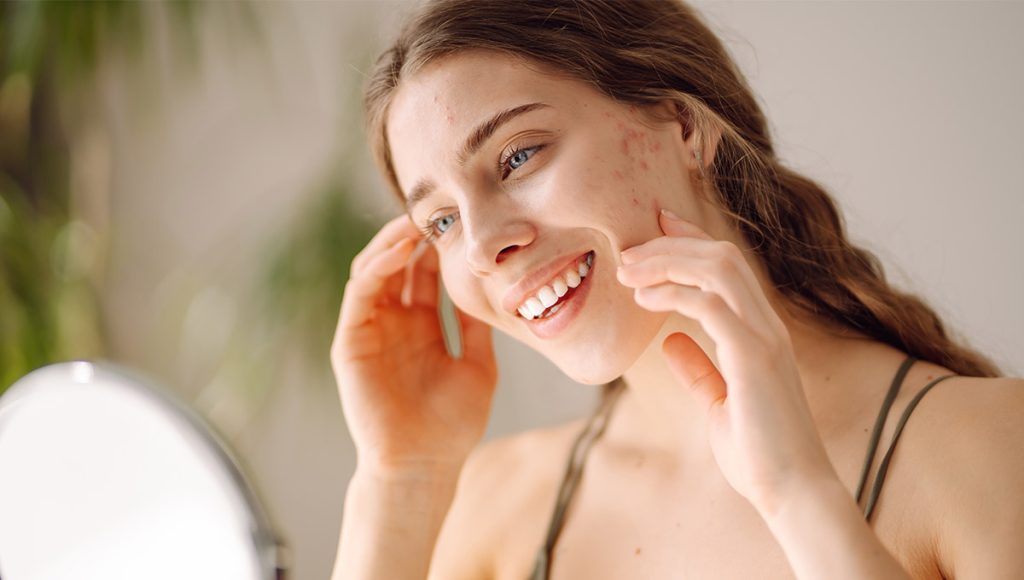
Once your pores are clearing out—congrats!—you’ll want to address what’s left behind: uneven tone, redness, and discoloration. Brightening the skin isn’t just about aesthetics. It’s about completion.
The best oil cleanser for sebaceous filaments sets the stage. Now it’s time to refine and enhance.
Vitamin C and Kojic Acid’s Role in Skin Brightness
Sebaceous filaments don’t always come solo. Sometimes they bring guests: post-inflammatory hyperpigmentation, dullness, and patchiness.
Fortunately, ingredients like kojic acid and vitamin C are brilliant at correcting this.
- Kojic acid: blocks melanin production and fades existing dark areas.
- Vitamin C: boosts radiance and repairs oxidative damage.
- Turmeric: reduces inflammation and brightens skin over time.
- Lemon extract: naturally exfoliates and evens out tone.
For an effortless glow boost, I swear by the Nasola Lemon Turmeric Kojic Acid Exfoliating Pads. Packed with turmeric and kojic acid, they gently promote an even canvas—without irritating active congestion.
Treating Hyperpigmentation Left by Inflamed Sebaceous Filaments
If you’ve tried to squeeze or over-exfoliate in the past, you might have residual spots.
These leftover marks need patience and the right ingredients:
- Licorice root: calms melanin production
- Kojic acid: continues fading while cleansing gently
- Niacinamide: reduces blotchiness and strengthens your skin barrier
- Papaya extract: naturally enzymatic and helps slough off dead skin
Be consistent. This is a slow reveal, not a quick-fix situation. But each time you treat your skin kindly, it responds.
Maintaining Skin Barrier Health After Deep Cleansing
Think of your skin like a house. You’ve done the deep-clean. Now it’s time to secure the foundation. That means hydration, defense, and daily protection.
Following up the best oil cleanser for sebaceous filaments with barrier-repairing essentials will keep your skin balanced, not brittle.
Importance of Hydration
Don’t mistake oil for moisture. Hydration = water content. Oil = emollient layer. You need both.
Especially after cleansing, restoring hydration is crucial to:
- Prevent dehydration-induced oil production
- Support barrier healing after exfoliants
- Ensure actives absorb without irritation
- Maintain supple, healthy texture
Layer on water-based serums with hyaluronic acid, and consider spritzing your skin mid-day if you’re in dry environments.
Choosing the Right Moisturizers
The ideal post-cleanse/moisture-lock formula?
Lightweight—but effective.
Key ingredients to seek:
- Ceramides: replenish lipids and protect barrier
- Niacinamide: boosts skin resilience
- Aloe vera: calms and hydrates
- Glycerin: pulls water deep into the skin
Avoid heavy occlusives or pore-clogging waxes though. Let your skin breathe.
Once you’ve hydrated and sealed in moisture, you’ve officially earned that soft, refined-glow look.
Gentle Yet Powerful: Daily Use Products That Support Pore Cleanliness

The best oil cleanser for sebaceous filaments opens the door, but to keep it clear every day, you need support products in your arsenal.
Daily-use items that clarify while being gentle will set the stage for sustained clarity.
Antioxidant and Anti-inflammatory Ingredients
Antioxidants snuff out oxidative stress (a major contributor to visible sebaceous filaments and dullness). Anti-inflammatory ingredients balance reactivity, making your skin more even and less prone to congestion.
Some superstars?
- Turmeric: soothes and purifies
- Lemon peel: brightens gently
- Papaya extract: exfoliates and clarifies skin
- Kojic acid: brightens and blocks bacteria
The Nasola Kojic Acid Soap is packed with these exact ingredients and makes a great companion to your routine. Use it on your nose, chin, back, or chest—wherever congestion tends to settle.
Purifying the Skin Gently
You don’t want to strip your skin post-oil cleanse, but you also don’t want to leave residues that might re-clog it.
That’s where a bar soap like the Nasola Kojic Acid Soap comes in. Gentle enough for daily use yet effective enough to:
- Sweep away sweat and grime
- Calm stressed spots
- Leave skin feeling smooth but never tight
- Prepare your face for acids or moisturizers
This tool is simple—but mighty.
Consistency is Queen: Long-Term Habits with the Best Oil Cleanser for Sebaceous Filaments
Skincare rarely offers instant gratification. The best oil cleanser for sebaceous filaments helps you improve clarity steadily and sensibly.
Here are the long-game rules:
Trust the Progress
Don’t hop from trend to trend. Stick with well-formulated products and:
- Track progress every 2 weeks in a mirror, not daily
- Use a consistent AM/PM cleansing and hydration routine
- Sleep on clean pillowcases
- Limit touching or picking congested areas
Listen, I’ve been there.
But trust me: showing your skin consistent love brings out your best glow.
Elevate Your Routine with Treatments
Once your baseline is solid, consider more advanced treatments—no rush though.
- Clay masks (weekly): pull toxins without drying
- LED therapy: reduce redness and bacteria
- Spot treatments with salicylic/citric acid
- Facial steaming: softens congestion between extractions
Use treatments thoughtfully—not obsessively—and always keep hydration a priority.
You’re not fixing your skin. You’re supporting it. There’s a difference.
Conclusion
Choosing the best oil cleanser for sebaceous filaments isn’t about perfection—it’s about creating balance. Your pores have a job to do, and when cared for with intention and guided by science-backed products, they can actually become your skin’s allies.
Start with gentle cleansing, consistent exfoliation, and brightening support. Products like the Nasola Kojic Acid Face Wash, Nasola Triple Acid Facial Radiance Pads, Nasola Lemon Turmeric Kojic Acid Exfoliating Pads, and Nasola Kojic Acid Soap make that journey easier—and more effective.
Trust the process. Your skin will thank you for it.
Frequently Asked Questions
Sebaceous filaments are naturally occurring structures that help guide oil through your pores. They’re often confused with blackheads, but they don’t clog or inflame the same way. Blackheads are actual plugs of oil and dead skin that oxidize and darken, while sebaceous filaments appear lighter in color and uniform in placement.
For most people, using an oil cleanser once daily (preferably in the evening) is sufficient to reduce congestion and keep sebaceous filaments in check. Double cleanse if you wear makeup or sunscreen. Watch how your skin responds and tweak accordingly.
While kojic acid is primarily known for its brightening power, it also offers mild antibacterial benefits that can help limit buildup that worsens sebaceous filaments. Using the Nasola Kojic Acid Soap can support clearer, more even-toned skin.
It depends on the formulation. The Nasola Triple Acid Facial Radiance Pads are designed to be gentle enough for frequent use, but it’s best to ease in. Begin with 3x a week and work your way up if your skin agrees.
To reduce sebaceous filaments faster, pair your oil cleanser with exfoliating agents like the Nasola Lemon Turmeric Kojic Acid Exfoliating Pads. These help dislodge buildup and prevent reoccurring congestion. Follow with a gentle, hydrating moisturizer.
Sebaceous filaments are a permanent part of your skin’s structure, especially in the nose area. You can’t eliminate them completely, but you can reduce their visibility and appearance with the right cleansing and exfoliating routine.
Because they’re part of your skin. Their appearance fluctuates based on your oil production, exfoliation habits, and hygiene. Consistent care and the use of effective products can calm them visually, but they’ll naturally re-form as your skin produces oil.
Yes! Turmeric has anti-inflammatory and antibacterial properties, so it helps manage the underlying causes of sebaceous filament formation. Try products like the Nasola Lemon Turmeric Kojic Acid Exfoliating Pads to support ongoing clarity.
Yes—especially one like the Nasola Kojic Acid Soap, which includes kojic acid, lemon, and papaya extracts to gently exfoliate and decongest skin. Bars are convenient and targeted, especially for spot-prone areas.
Use hydrating ingredients (like hyaluronic acid or aloe), avoid over-exfoliating, and pair your routines with gentle formulations. Avoid alcohol-based toners and stick with oil cleansers followed by nourishing serums and moisturizers.


